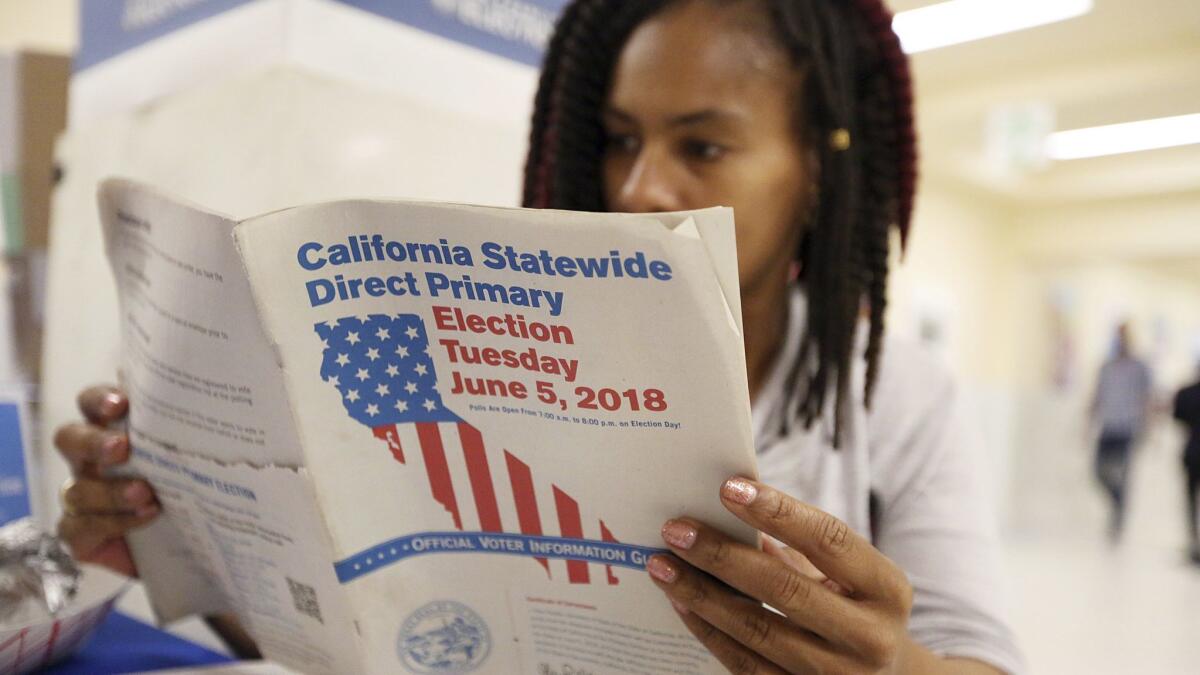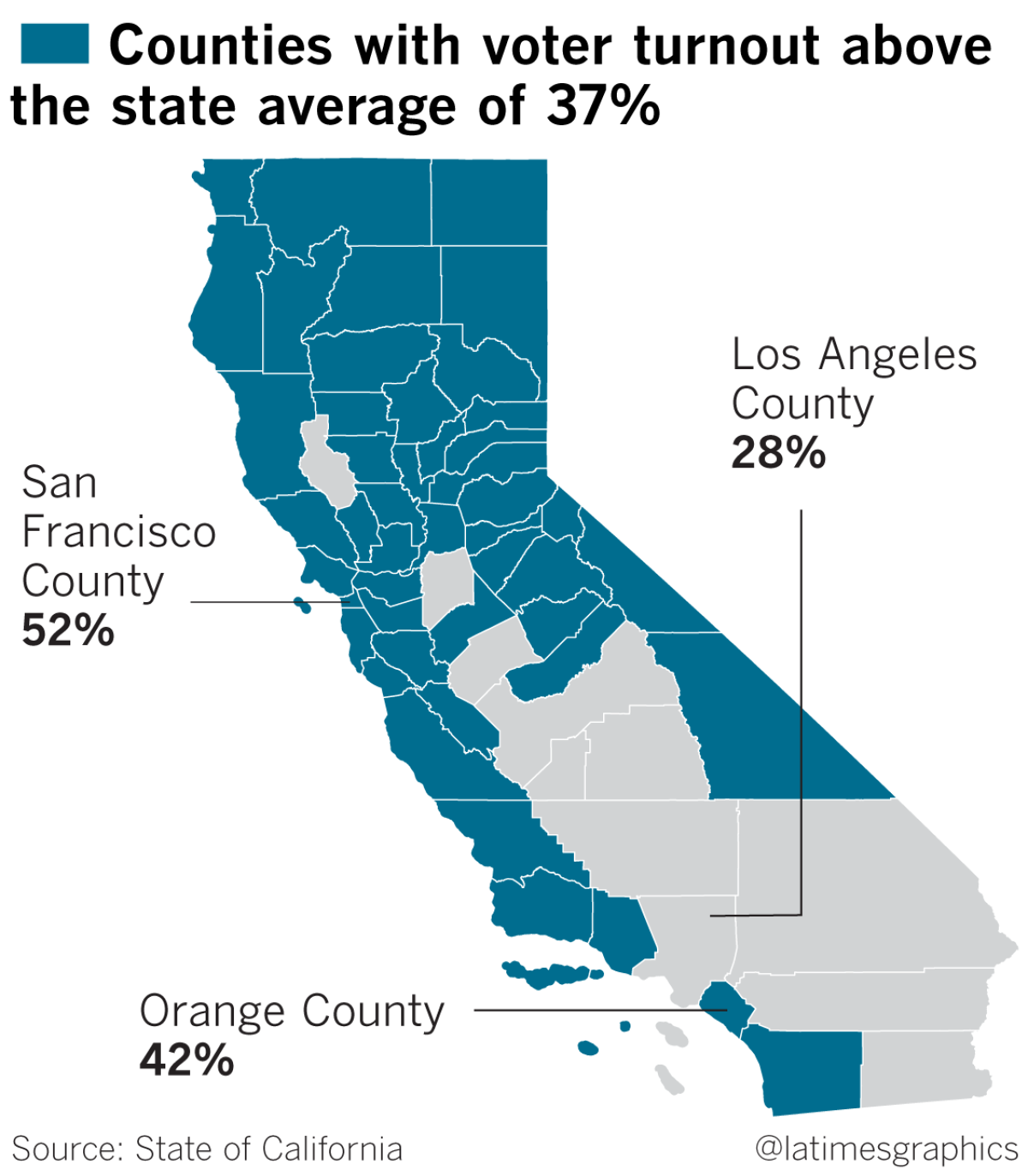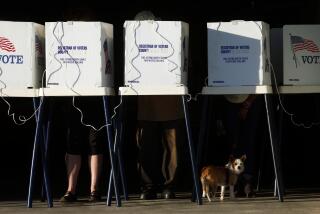California’s primary election saw higher turnout than recent years, but most voters still skipped it

- Share via
Reporting from Sacramento — In a sign of how modest expectations have become of Californians actually casting ballots, elections officials and advocates alike found relief Monday in the final tally showing 37% of voters cast ballots in June — small compared with total registration but the highest for a nonpresidential primary since 1998.
Slightly more than 7.1 million voters participated in last month’s statewide election. Although it’s the third-highest number of ballots ever cast in a California primary — the record was set in 2000 — last month’s turnout was roughly equal to the average from similar elections since 1982.
Just hitting the historic benchmark, though, is notable. Four years ago, statewide primary turnout dropped to a record low 25%. The tone of that election season was far more tepid; this time, pockets of the Golden State heard the call to arms in a national partisan battle that energized at least some number of voters.
Also different than years past were new state laws designed to lower the barriers to participation. For whatever reason, be it frenzied politics or sober reforms, advocates said they hope June’s results are more trend than transitory.
“We’re making progress — slowly, but it’s progress,” said Helen Hutchison, president of the League of Women Voters of California.
Forty-seven counties reported voter turnout on June 5 higher than the statewide average, though many of the localities are rural regions with relatively few voters. Only 15 counties saw a majority of registered voters cast ballots.
Los Angeles County reported voter turnout of 28%, the second lowest in California but a high water mark compared with previous primaries in off-year elections. Four years ago, the total was fewer than 1 in 7.
“Increases in voter participation likely depend on the extent to which we can make voting relevant to a broader population of the electorate,” said Dean Logan, county registrar of voters.

Six of the 10 largest counties by population beat the statewide 37% average, most of those in Northern California. That follows one of the state’s well-known political axioms: Southern California may have more voters, but they are less likely to show up on election day.
That phenomenon often helps north-state candidates, a truism reinforced by Lt. Gov. Gavin Newsom’s strong showing in June’s race for governor compared with his closest Democratic rival, former Los Angeles Mayor Antonio Villaraigosa.
Final numbers, with a formal certification of the results expected on Friday, show some 239,000 more ballots were cast across the Bay Area’s nine counties than in Los Angeles County — even though it’s home to 1.2 million more registered voters than the northern counties combined. Newsom’s home territory accounted for almost 4 of every 10 votes he received.
For Republicans, who feared a shutout of the state’s top races that could lead party voters to skip the November election, saw strength in their base communities. That could have been helped by President Trump’s decision to endorse a GOP candidate, John Cox, in the race for governor. The nine counties with the largest Republican registration advantage, though smaller than those dominated by Democrats, all beat the statewide turnout average.
Here’s why it can take weeks to count all of California’s ballots »
In some cases, intense local races appear to have helped boost turnout. In San Francisco, where voters weighed in on a heated race for mayor, elections officials reported 52% turnout — higher than the city has seen, according to state election records, for any nonpresidential primary in at least the last quarter-century.
In Orange County, home to four closely watched congressional races drawing national attention, 42% of voters cast ballots. A review by Political Data Inc., a private election analysis firm, found an average boost of 21 percentage points in the districts compared with 2014.
But here, too, the conclusion drawn depends on the way the numbers are viewed. Although voters in those congressional districts were more energized than four years ago, there was either no uptick compared with 2016 or, in some cases, it appears overall turnout actually shrunk.
The numbers are especially striking in some subgroups: Latino voters make up 20% of Orange County’s registered electorate but only 14% of the votes cast last month.
“Voter participation is a complex issue and influenced by a number of factors,” Hutchison said.
Of particular interest to voting rights groups were the impact of a handful of voting changes, some more wide-ranging than others, enacted by lawmakers since 2014. Ballots received in county offices three days after an election are now required to be counted, as long as they were postmarked no later than election day. Last month’s primary was also the first to allow voter registration on election day, an effort designed to encourage those who get interested late in the campaign season. It will probably take weeks or months to fully sift through data to assess the effect of those changes.
One key question in June’s primary was whether more voters would show up in five California counties — the first proving grounds for the most sweeping change made to state elections. Those communities were the first to enact the “California Voter’s Choice Act,” a 2016 law allowing counties to discontinue the use of neighborhood polling places and exchange them with all-mail ballots and a handful of vote centers with a variety of election services.
Of the five counties that used the new system — Sacramento, Napa, Nevada, Madera and San Mateo — only one, Nevada County, saw turnout above 50%. In general, the numbers represented only modest improvements in turnout from past gubernatorial primaries.
“Most of the new innovations are focused on removing impediments – making it more convenient to register and to vote, opening up early voting, improving access for language minorities and people with disabilities,” said Dora Rose, deputy director of the League of Women Voters of California.
California’s terms of office for statewide officials — from governor to attorney general and beyond — are staggered with each presidential term, thus occurring at the midway point of the national campaign cycle. The practical effect has almost always been lower voter turnout for the state contests, even though those officials hold far greater power over everyday life for Californians than does the president.

The highest turnout for a gubernatorial primary in the state’s modern era was in 1978, when almost 69% of registered voters showed up. From there, the numbers steadily fell until 1998, when an open race for governor sparked a spirited campaign between three Democrats. Forty-two percent of voters cast ballots in that primary, and the numbers have dropped ever since.
Additional changes in the election process could help. Two bills, passed by the California Legislature, could reduce the number of voters who fail to get their ballot counted. One would require postage-paid envelopes be sent with ballots in the mail, while the second would require county officials to contact a voter whose ballot signatures don’t match.
“Both of these bills cost money to enact, but spending resources now to support voters would demonstrate that California’s leaders believe democracy is a worthwhile investment,” said Kim Alexander, president of the nonpartisan California Voter Foundation.
Others suggest looking at the problem of participation beyond those who are already registered. When including all eligible Californians — not just those who are currently registered to vote — the effective participation in the June 5 primary drops to only 28% of the state’s citizens.
Times columnist Steve Lopez wrote after the primary that “voter apathy is nothing new in California,” an opinion that generated hundreds of comments and tens of thousands of social media interactions.
“We need to make sure election information is in plain language and available in multiple languages, provide clear explanations of ballot measures, shed light on campaign finance, and make it easier for voters to hear directly from candidates,” Rose said.
“Not only do we want to see voter participation increased, we want to see California’s electorate be more representative,” she said.
Follow @johnmyers on Twitter, sign up for our daily Essential Politics newsletter and listen to the weekly California Politics Podcast
More to Read
Get the L.A. Times Politics newsletter
Deeply reported insights into legislation, politics and policy from Sacramento, Washington and beyond. In your inbox three times per week.
You may occasionally receive promotional content from the Los Angeles Times.











